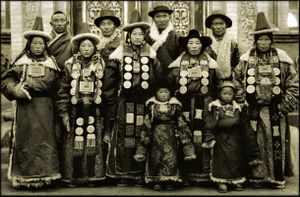يوغور
 | |
| إجمالي التعداد | |
|---|---|
| 15,000 (est.) | |
| المناطق ذات التجمعات المعتبرة | |
| Sunan Yugur Autonomous County, Gansu, China | |
| اللغات | |
| Western Yugur, Eastern Yugur | |
| الدين | |
| Tibetan Buddhism, Tengrism (Turkic Shamanism) | |
| الجماعات العرقية ذات الصلة | |
| Old Uyghurs, other Turks and Mongols |
The Yugurs, Yughurs, Yugu (الصينية: 裕固族; پنين: Yùgù Zú), or Yellow Uyghurs,[1] as they are traditionally known, are a Turkic and Mongolic group and one of China's 56 officially recognized ethnic groups, consisting of 13,719 persons according to the 2000 census.[2] The Yugur live primarily in Sunan Yugur Autonomous County in Gansu, China. They are Tibetan Buddhists.[3][4]
اليوغور هم مجموعة عرقية صينية وينبغي التفريق بينهم وبين قبيلة الأويغور المسلمة
التاريخ
The Turkic-speaking Yugurs are considered to be the descendants of a group of Uyghurs who fled from Mongolia southwards to Gansu after the collapse of the Uyghur Khaganate in 840, where they established the prosperous Gansu Uyghur Kingdom (Ganzhou Uyghur Khanate) (870-1036) with capital near present Zhangye at the base of the Qilian Mountains in the valley of the Ruo Shui.[5] The population of this kingdom, estimated at 300,000 in Song chronicles, practised Manichaeism and Buddhism in numerous temples throughout the country.
In 1037 the Yugur came under Tangut domination.[6] The Gansu Uyghur Kingdom was forcibly incorporated into the Western Xia after a bloody war that raged from 1028–1036. Mahmud al-Kashgari, who lived at the time in Kashgar, stated that "Uyghur blood was pouring like a murmuring stream" during this war.[بحاجة لمصدر]
The Mongolic-speaking Yugurs are probably the descendants of one of the Mongolic-speaking groups that invaded North China during the Mongol conquests of the thirteenth century. The Yugurs were eventually incorporated into Qing China in 1696 during the reign of the second Qing ruler, the Kangxi Emperor (1662–1723).
الدين
| جزء من سلسلة عن |
| بوذية ڤاجرايانا |
|---|
 |
The traditional religion of the Yugur is Tibetan Buddhism, which used to be practised alongside shamanism.
الهامش
- ^ Justin Jon Rudelson; Justin Ben-Adam Rudelson (1997). Oasis Identities: Uyghur Nationalism Along China's Silk Road. Columbia University Press. pp. 206–. ISBN 978-0-231-10786-0.
- ^ Justin Keith Brown, Sarah Ogilvie (2009). Concise encyclopedia of languages of the world. Elsevier. p. 1142. ISBN 0-08-087774-5. Retrieved 2010-10-31.
- ^ Justin Ben-Adam Rudelson, Justin Jon Rudelson (1997). Oasis identities: Uyghur nationalism along China's Silk Road. Columbia University Press. p. 178. ISBN 0-231-10786-2. Retrieved 2010-10-31.
- ^ Wong, Edward (September 28, 2016). "Modern Life Presents Nomads of China's Steppe With a 'Tragic Choice'". New York Times.
- ^ Edward Allworth (1994). Central Asia, 130 years of Russian dominance: a historical overview. Duke University Press. p. 89. ISBN 0-8223-1521-1. Retrieved 2010-10-31.
- ^ Michael Dillon (2004). Central Xinjiang: China's Muslim far northwest. Psychology Press. p. 10. ISBN 0-415-32051-8. Retrieved 2010-10-31.
وصلات خارجية
- Slide shows, maps and other material on the Yugur from author Eric Enno Tamm
- Original Western Yugur texts with English translation plus PDF grammar of Sarig Yugur [1]
أدبيات
- Tamm,Eric Enno. (2010) "The Horse That Leaps Through Clouds: A Tale of Espionage, the Silk Road and the Rise of Modern China." Vancouver: Douglas & McIntyre. ISBN 978-1-55365-269-4. http://horsethatleaps.com/chapter-11
- Articles with hatnote templates targeting a nonexistent page
- Missing redirects
- "Related ethnic groups" needing confirmation
- Articles using infobox ethnic group with image parameters
- Articles containing Chinese-language text
- Articles with unsourced statements from March 2018
- عرقيات آسيا
- جماعات عرقية
- شعوب منغولية
- شعوب توركية في آسيا
- Ethnic groups officially recognized by China
- Uyghurs